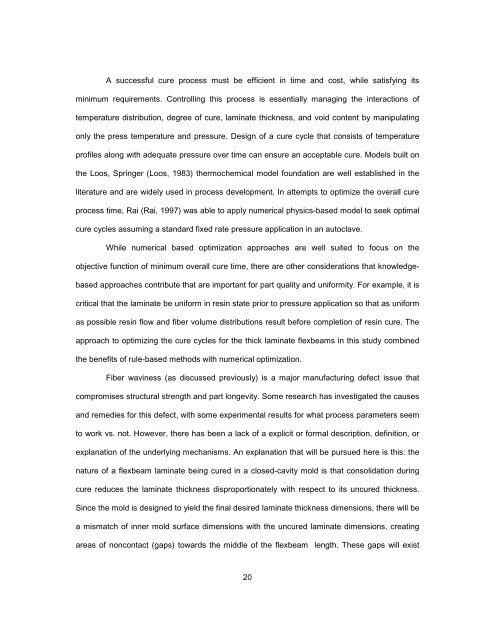TOOLED THICK COMPOSITES by ARVEN H. SAUNDERS III ...
TOOLED THICK COMPOSITES by ARVEN H. SAUNDERS III ...
TOOLED THICK COMPOSITES by ARVEN H. SAUNDERS III ...
Create successful ePaper yourself
Turn your PDF publications into a flip-book with our unique Google optimized e-Paper software.
A successful cure process must be efficient in time and cost, while satisfying its<br />
minimum requirements. Controlling this process is essentially managing the interactions of<br />
temperature distribution, degree of cure, laminate thickness, and void content <strong>by</strong> manipulating<br />
only the press temperature and pressure. Design of a cure cycle that consists of temperature<br />
profiles along with adequate pressure over time can ensure an acceptable cure. Models built on<br />
the Loos, Springer (Loos, 1983) thermochemical model foundation are well established in the<br />
literature and are widely used in process development. In attempts to optimize the overall cure<br />
process time, Rai (Rai, 1997) was able to apply numerical physics-based model to seek optimal<br />
cure cycles assuming a standard fixed rate pressure application in an autoclave.<br />
While numerical based optimization approaches are well suited to focus on the<br />
objective function of minimum overall cure time, there are other considerations that knowledge-<br />
based approaches contribute that are important for part quality and uniformity. For example, it is<br />
critical that the laminate be uniform in resin state prior to pressure application so that as uniform<br />
as possible resin flow and fiber volume distributions result before completion of resin cure. The<br />
approach to optimizing the cure cycles for the thick laminate flexbeams in this study combined<br />
the benefits of rule-based methods with numerical optimization.<br />
Fiber waviness (as discussed previously) is a major manufacturing defect issue that<br />
compromises structural strength and part longevity. Some research has investigated the causes<br />
and remedies for this defect, with some experimental results for what process parameters seem<br />
to work vs. not. However, there has been a lack of a explicit or formal description, definition, or<br />
explanation of the underlying mechanisms. An explanation that will be pursued here is this: the<br />
nature of a flexbeam laminate being cured in a closed-cavity mold is that consolidation during<br />
cure reduces the laminate thickness disproportionately with respect to its uncured thickness.<br />
Since the mold is designed to yield the final desired laminate thickness dimensions, there will be<br />
a mismatch of inner mold surface dimensions with the uncured laminate dimensions, creating<br />
areas of noncontact (gaps) towards the middle of the flexbeam length. These gaps will exist<br />
20
















